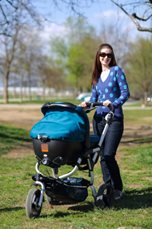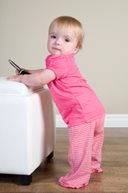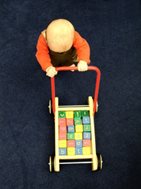Nursery Equipment
Car Seats and Capsules .jpg.aspx?width=140&height=195)
Some capsules and car seats are quite heavy to lift. They can be good for use in the car, but they are not recommended for carrying a small baby around in, as this can place strain on your back and wrists. As your baby gets heavier but still fits in the capsule or seat, this strain can continue. Consider either buying something that is safe but lighter to carry if you would like to use it in this way, otherwise just use the capsule or seat in the car, and plan to use a pram or a sling for carrying your baby at other times.
Change Tables 
As you can spend a lot of time changing your baby over the next few years, it is important that your table is at a good height so that you don’t have to bend over the table too much and get a sore back. When women in hospital use the bed to change their baby on, they soon notice that it doesn’t take long to get a backache from bending over, even for a short time.
Your baby will grow, and as they get bigger and longer, your change table needs to accommodate this. Some tables may be suitable for newborns, but may not be wide enough to continue using as time goes on.
Sometimes a softer surface for the baby to lie on can mean that it is harder for them to move, as they sink into the support more than on a harder surface. This may be particularly useful as your baby becomes more active as they get older, and wants to roll over or sit up while you are trying to change them.
Baby Baths 
Consider first where you are going to put a baby bath and at what height this will be. Are you going to be leaning over the bath, which could lead to an aching back, or do you have a bench or table at a good height for standing or sitting to bath your baby? The most convenient option for you and your baby is getting the best baby bath seat, as it gives support and hands free to shampoo your baby.
You need to think about where you are going to put all the things that you need for washing your baby. When you first get home with your baby or babies, you don’t want to be reaching up on top of your wardrobe to get down everything you need. If possible be prepared before hand, have everything close so that when you do bath your baby you don’t need to stop half way through to go off and get something. You will also need a safe place to dry your baby after you take them out of the bath; again this can place strain on your back. This is especially important when your baby is quite young and your stomach muscles are still lengthened, as your back is quite weak (due also to the effect of the pregnancy hormones in your body which won’t have gone yet).
So think about these things before you buy a baby bath. Some people decide not to buy one, using a laundry tub to bath their baby in, or deciding to wash their baby in the shower at the same time as Mum or Dad (although you may not feel that it is as easy to wash your baby in the shower). Using your normal bath may also be an option, but you may need to get in, as leaning over a bath to hold a small baby can also give you a backache.
The other thing to think about is how long you are able to use it, as babies can outgrow a baby bath quite quickly.
Prams 
Where and how do you think you will mainly use the pram?
• For walking, you need to make sure the pram handle is at a good height so that you don’t need to lean over the pram when taking your baby for a walk. Using your wrist crease as a guide for the height of the handle will mean that you will have a slight bend at your elbow, and should be able to stand tall whilst walking.
• Wheel size is also important, especially if you don’t live in an area with good footpaths. Often prams with larger single wheels are easier to push than smaller double wheels.
• Wheels that move freely can be easier to manoeuvre than wheels that are locked and do not move. This may be important to consider if you will use your pram while shopping or in places with limited space to move the pram around.
• Putting the pram in and taking it out of the car can be a frequent occurrence, so it is important to consider how easy this is to do, and whether it actually fits into your car. Also consider how heavy the pram is. If a pram is too heavy for you, it can place strain on your back when you lift it in and out of the car.
Do you need to disassemble it every time to fit it into your car?
Time is also important when you have a toddler, as their patience is limited and you may need to restrain them while you are trying to get the pram sorted out. If this is your first baby, you may not be thinking as far ahead as having other children in the future. But if this is a possibility, it is important to remember that you will want a pram that is easy to handle while you are pregnant.
When will you use the pram?
• Consider whether the pram is suitable for a newborn, as well as for when your baby becomes older. Some prams may not recline completely for a newborn to lie in, so they need to be adjustable to meet your needs.
• Toddler seating.
o If you plan to have more than one child, consider whether you will buy a pram now that will allow the attachment of a toddler seat later on when it is needed.
Making the right CHOICE
To help you be confident that your purchase is durable, easy to use and most importantly safe for your baby, visit this review and compare by CHOICE.
Baby Walkers
Many people think that baby walkers look like a good thing to buy for their children. Babies may like them, but there is another viewpoint, which you may not have considered.
Using a baby walker means that your baby will be taking weight through their legs, hips, pelvis and back before they are really ready to. If the baby is allowed to walk on their toes while in a walker, this can affect the pattern of their walking later on.
 Normally babies start to take weight through their body while sitting, then through their legs when they get into a hands and knees position before they begin to crawl. You may notice your baby spends time rocking backwards and forwards in this position for some time, even weeks, before they actually start to crawl. The reason for this is that their muscles are strengthening and they are gaining the stability that they need before they start moving their legs to crawl.
Normally babies start to take weight through their body while sitting, then through their legs when they get into a hands and knees position before they begin to crawl. You may notice your baby spends time rocking backwards and forwards in this position for some time, even weeks, before they actually start to crawl. The reason for this is that their muscles are strengthening and they are gaining the stability that they need before they start moving their legs to crawl.
 A similar thing happens when they develop further and pull themselves up into standing while holding on to furniture, and then start to cruise along the furniture. Their muscles continue to strengthen and develop further until they can stand unsupported, before beginning to take steps and walk. This is a natural progression of development and playing on the floor will allow this to occur. Your baby will develop strength, balance and co-ordination by progressing through these different stages. Walking may actually be delayed if a baby spends time in a walker because they are not getting these normal experiences.
A similar thing happens when they develop further and pull themselves up into standing while holding on to furniture, and then start to cruise along the furniture. Their muscles continue to strengthen and develop further until they can stand unsupported, before beginning to take steps and walk. This is a natural progression of development and playing on the floor will allow this to occur. Your baby will develop strength, balance and co-ordination by progressing through these different stages. Walking may actually be delayed if a baby spends time in a walker because they are not getting these normal experiences.
There are also safety issues to consider when using walkers. A baby is able to reach and get to things that they wouldn’t normally at their stage of development. Steps and stairs also can be dangerous to a baby in a walker, as a baby cannot see them and may topple over while in the walker.
What can I use instead of a Baby Walker?
 Trolleys with toy wooden blocks in or toys that have a handle and can be pushed, can assist a baby to walk supported while they are still developing. These are much safer to use than baby walkers. If you already have a walker, use it as a push along toy instead of sitting the baby on the inside of it. Be careful though, as if these move too quickly for your baby, it may slip away from them and they may topple over. Babies may also become frustrated if you use a walker and then they are placed back on the floor where they have to make the effort to move themselves.
Trolleys with toy wooden blocks in or toys that have a handle and can be pushed, can assist a baby to walk supported while they are still developing. These are much safer to use than baby walkers. If you already have a walker, use it as a push along toy instead of sitting the baby on the inside of it. Be careful though, as if these move too quickly for your baby, it may slip away from them and they may topple over. Babies may also become frustrated if you use a walker and then they are placed back on the floor where they have to make the effort to move themselves.
You may also take wheels off a baby walker and use it just to sit the baby in for play, while allowing your baby’s feet to either be placed flat on the floor so they can’t push up through their toes or have it so their feet can’t touch the floor at all.
Safety
To consider the different issues on safety when choosing baby furniture, a very comprehensive and useful booklet, “Keeping Baby Safe: A guide to nursery furniture”, has been produced by the Ministerial Council on Consumer Affairs, Australia. This booklet is available to read on-line at:
Keeping baby safe - links
Keeping baby safe - PDF version
CHOICE also has an article on "Ten things not to buy your kids".
Compiled by Demac Resources Pty Ltd 2012 - 2020. www.thepregnancycentre.com.au